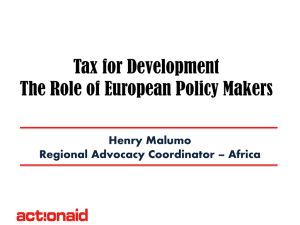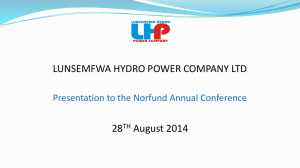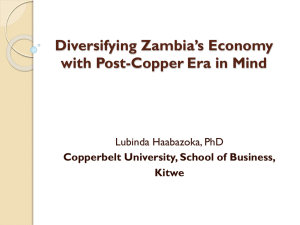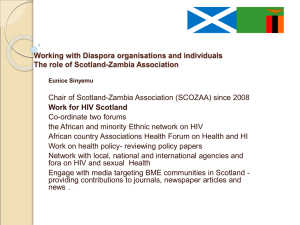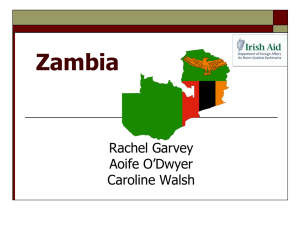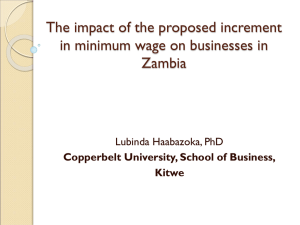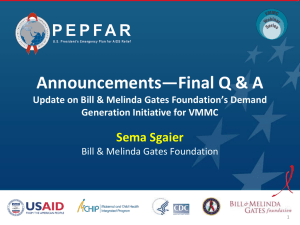File
advertisement
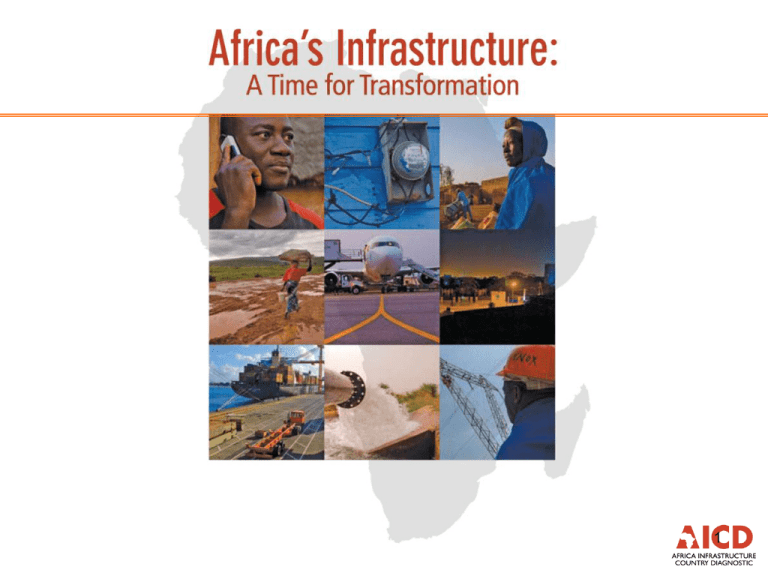
1 Zambia’s Infrastructure: A Continental Perspective Africa Infrastructure Country Diagnostic: a multi-stakeholder effort Banque Africaine de Developpement African Union Agence Française de Développement Development Bank of Southern Africa Department for International Development European Union The Infrastructure Consortium for Africa Kreditanstalt für Wiederaufbau The New Partnership for Africa’s Development Public-Private Infrastructure Advisory Facility Sub-Saharan Africa Transport Project The World Bank Water and Sanitation Program Methodology and approach Methodology Data collection by local/international consultants and Bank staff based on standardized methodology Baseline year for data is 2006, does not reflect subsequent evolution Approach Focus on benchmarking Zambia’s infrastructure against African neighbors Benchmarking group includes Resource Rich Countries (RR), Middle Income Countries (MIC), South African neighbors, and regional outliers Why infrastructure matters? Despite Zambia’s strong economic growth, infrastructure’s contribution has been relatively low Changes in growth per capita due to changes in infrastructure (2001-5 vs. 1991-5) 2.5 2.0 1.5 1.0 0.5 Telecom Electricity Roads Guinea-Bissau Zimbabwe Angola Zambia South Africa Madagascar Malawi Botswana Mauritius -0.5 Sudan 0.0 Raising Zambia’s infrastructure to level of African leader could add 2.2 points to per capita growth rate Potential changes in growth per capita from improving infrastructure to level of African regional leader (Mauritius) 5 4 3 2 Main Telephone Lines Mauritius Botswana Zambia Zimbabwe Angola Electricity Generating Capacity South Africa -2 Madagascar Malawi -1 Niger 0 Togo 1 Length of Road Network Key Message #1 Infrastructure has the potential to contribute more to Zambia’s infrastructure than it has in the past The State of Zambia’s Infrastructure Zambia’s power network Benchmarking highlights exceptionally low power tariffs and levels of electrification Unit Installed power generation capacity Power consumption Power outages Firms’ reliance on own generator Firms’ value lost due to power outages Access to electricity Urban access to electricity Rural access to electricity Growth access to electricity Revenue collection System losses Cost recovery Total hidden costs as % of revenue US cents Effective power tariff (residential at 100 kWh) Effective power tariff (commercial at 100 kWh/mo) Effective power tariff (industrial at 50,000 kWh) Resource Rich Zambia MIC MW/mil. people kWH/capita Day/year % consumption % sales % population % population % population % population/year 43.17 205.68 14.52 44.92 6.99 46.05 79.41 28.03 154.9 771.0 49.8 19.5 3.7 20.1 50.0 3.5 798.6 4,479.3 5.9 10.9 1.6 59.9 85.2 31.8 2.38 0.3 1.5 % billings % production % total cost % of revenue 81.07 25.80 53.94 168.29 96.5 12.0 39.1 93.3 100.0 10.1 100.0 0.1 Zambia Predominantly Hydro Generation 2.9 10.27 4.4 11.73 2.9 11.39 Other Developing Regions 5.0 – 10.0 Zambia’s power prices are the lowest in Africa, and also look low by global standards 30 25 US$ cents 20 15 10 5 Power tariffs in other developing countries: lower bound Zambia Nigeria Malawi Congo Ethiopia Mozambique South Africa Lesotho Ghana Tanzania Namibia Côte d'Ivoire Benin Niger Cameroon Rwanda Kenya Senegal Uganda Madagascar Cape Verde Chad 0 Power tariffs in other developing countries: upper bound Zambia’s power tariffs appear in line with operating costs but far from long-run capital costs Hidden costs of power utilities are high due to underpricing Unaccounted losses Under-pricing Collection inefficiencies DRC Congo Malawi Chad Niger Nigeria Tanzania Rwanda Botswana Ghana Uganda Zambia Cameroon Senegal Lesotho Ethiopia Mozambique Congo, Rep. Cape Verde Burkina Faso Kenya Benin Madagascar 0 100 200 300 400 Percentage of revenues 500 600 700 Access to power highly inequitable making any subsidies to sector highly regressive No affordability problems for those with access, nor even many of those without % of households spending less than 5% of their monthly budget 100% 90% 80% 70% 60% 50% 40% 30% 20% 10% 0% 1 2 3 4 5 6 7 8 9 10 11 12 USD/month Lower/Upper bound cost of household consumption of electricity Zambia LIC Key Message #2 Meeting future power demands and raising electrification will be difficult without higher power tariffs Road network traffic concentrated between Lusaka and Copper belt Main trunk network in good condition except in outlying areas Benchmarking indicates possible over-engineering of paved network in contrast to poor unpaved network Paved road density Unit Resource Rich Zambia MIC km/1000 km2 97.6 56.3 146.8 128.2 95.0 257.8 19.7 16.8 22.9 Total road network km/1000 km2 of arable density land GIS Rural % of rural pop within 2 accessibility km from all-season road Over-engineering % of main road network paved relatively to low traffic 15.0 65.0 20 Paved road traffic Average Annual Daily Traffic 1408.2 736.6 2558.3 54.2 45.2 14.9 67.9 83 82.0 61.4 21 57.6 27.4 10.6 4.8 Unpaved road Average Annual Daily Traffic traffic Paved network % in good or fair condition condition Unpaved classified % in good or fair network condition condition % firms identifying as Perceived transport major business quality constraint Maintenance norm Maintenance&Rehabilitation norm 200 150 100 50 Zambia Namibia Malawi Lesotho -100 Madagascar -50 South Africa 0 Mozambique percentage deviation from norm Zambia has secured resources to cover road maintenance and rehabilitation needs of main road network Levels of road sector spending are high in absolute terms and relative to GDP 4.5 As % GDP 35 US$ per capita 4.0 30 2.5 20 2.0 15 1.5 10 1.0 5 0.5 South Africa Namibia Lesotho Madagascar Zambia 0 Mozambique 0.0 US$/cap 25 3.0 Malawi % of GDP 3.5 Key Message #3 Strong budget envelope and apparent over-engineering of main roads suggests potential to shift resources to under-served rural roads Zambia’s rail sector is a critical input for a minerals based economy Staff: 1000 UT per Staff Coaches: 1000 passenger-km per coach Cars: 1000 ton-km per wagon Locomotive Availability in % TARIFFS: Average Unit Tariff, Freight, US cents/ton-km Aver. Unit Tariff, Passenger, US cents/passenger-km Zimbabwe S. Africa ZR Spoornet CEAR Malawi Botswana BRC CFM TransNami b Namibia Railway Concessioned (1)/ State run (0) Traffic Density, Freight, 1000 tonkm/km EFFICIENCY: Angola Zambia RSZ Country TAZARA Zambia Benchmarking indicates low traffic density and relatively poor performance in terms of efficiency 1 0 0 0 1 0 0 0 406 461 469 827 662 475 2427 902 502 339 121 105 281 358 57 36 3286 nav 4045 2391 750 nav nav nav 377 nav 950 987 476 805 913 195 25 nav 30 41 13 25 33 8 4.9 nav 3 2.4 5.8 nav nav nav 3.9 nav 1 1.3 1 nav nav nav Railway institutional reform scores relatively low indicating need to further develop supervision Institutional Reform Score 35% 30% 25% 20% 15% 10% 5% Governance Regulation Reform Benin Rwanda Congo DRC Namibia South Africa Zambia Madagascar Tanzania Burkina Faso Cameroon Mozambique Cote d'Ivoire Malawi Senegal Uganda Kenya 0% Key Message #4 Improving supervisory framework could help to boost performance of rail concession Concentrated potential for large scale irrigation with modest returns Simulated location of potential LARGE scale irrigation schemes Scattered potential for small scale irrigation with higher returns Simulated location of potential SMALL scale irrigation schemes Benchmarking indicates tendency to focus on higher end solutions and poor utility performance Access to piped water Access to stand posts Access to wells/boreholes Access to surface water Access to flush toilets Access to improved latrines Access to traditional latrines Open defecation Domestic water consumption Urban water assets in need of rehabilitation Revenue collection Distribution losses Cost recovery Labor Costs Total hidden costs as % of revenue US cents per m3 Residential tariff Non-residential tariff (*) Average of 3 providers Unit % pop % pop % pop % pop % pop % pop % pop % pop liter/capita/day per population served Resource Rich Zambia MIC 12.0 12.6 49.0 23.7 1.6 6.4 54.8 27.6 90.3 18.3 15.6 46.9 19.0 18.1 1.6 53.1 27.0 80.7 52.1 18.9 6.0 13.0 40.8 1.4 30.4 14.3 187.6 % 42.0 42.0 25.0 % sales % production 69.7 43.6 55.6 95.7 286.7 68(*) 44.9 65.4 98.8 311.4 100 27.4 80.6 210.8 1854.2 % total costs connections per employee % Zambia Scarce water resources Other Developing Regions 48 59 60 120 3.00 – 60.00 Dramatic urban – rural gaps and apparent declining coverage of piped water with increases elsewhere Urban 70% Rural 60% 50% 40% 30% 20% 10% Piped water Standpost Well/boreholes 2001-2005 1996-2000 1990-95 2001-2005 1996-2000 1990-95 2001-2005 1996-2000 1990-95 2001-2005 1996-2000 1990-95 0% Surface water Strong expansion of wells and boreholes, but worrisome increase in use of surface water Expansion of sanitation options below the SSA average and troublesome expansion of open defecation Hidden costs of Zambia’s water utilities are the highest in the region Hidden costs (% of the revenues) Zambia Mozambique Malawi Namibia Lesotho South Africa Madagascar 0% 50% Unaccounted losses As of 2005 100% Under-pricing 150% Collection inefficiencies 200% 250% Key Message #5 Greater attention to sanitation and rural services needed, opportunity to harness new resources by improving efficiency Zambia’s ICT network very tightly clustered around economic centers Benchmarking indicates relatively low GSM coverage and relatively high price of calls Unit GSM coverage International bandwidth Internet Landline Mobile phone Labor productivity Quality of service % population Mbps/capita subscribers/100 people subscribers/100 people subscribers/100 people Subscribers/employee Faults per 100 main lines Zambia Resource Rich 66.9 4.0 0.1 19.3 11.4 405.1 82.4 Zambia MIC 53.0 4.4 0.2 8.5 20.9 505.8 90.8 85.1 104.0 3.0 34.8 30.0 756.8 50.8 Price of monthly mobile basket 14.6 Without Submarine Cable 11.1 Other Developing Regions 9.9 Price of monthly fixed line basket 8.9 13.6 nav Price of 20-hour Internet package Price of a 3-min call to US Price of inter-Africa tel. calls, mean 81.5 5.5 1.19 68.0 2.6 0.7 11.0 2.0 Source: Preliminary results AICD 2008 High international call charges driven both by technology and market power US$ Percent cases Call within SSA Call to USA Internet dial-up Internet ADSL Without submarine cable 67% 1.34 0.86 68 283 With submarine cable 33% 0.57 0.48 47 111 monopoly on international gateway 16% 0.70 0.72 37 120 competitive international gateway 16% 0.48 0.23 37 98 Some potential for private expansion of GSM coverage and only minimal need for subsidy Percent of population Existing access 100% 90% 80% 70% 60% 50% 40% 30% 20% 10% 0% Efficient Market Gap Coverage gap Key Message #6 Further competition across the board is needed to drive down prices and expand access The AICD Financial Framework 100% 80% Spending needs Funding gap 60% Efficiency gap 40% 20% Existing spending 0% Improving operational efficiency $7.5 Increasing cost recovery Prioritizing public spending $3.3 All figures in US$ billion a year Spending budgeted resources $1.9 Key Message #7 Zambia needs to spend around US$16 billion over the next decade to catch-up with the rest of the developing world Illustrative infrastructure targets over next ten years Economic target Social target ICT Fiber optic links to neighboring capitals and submarine cable Universal access to GSM signal and public broadband facilities Power 1,700MW refurbished capacity, 1,700 MW new generation OR, 7,500 MW inter-connectors Electricity coverage of 24% (50% urban and 15% rural) Regional connectivity by good quality 2 lane paved road National connectivity by good quality 1 lane paved road Rural Accessibility Index 100% for high value agricultural land, Urban popn within 500m paved road Na. Achievement of MDG for water and sanitation Transport WSS To meet these targets, Zambia would need to spend US$1,609 million a year for the next decade US$ bn pa Capital O&M Total Percentage ICT 132 86 218 14% Power 532 99 631 39% Transport 145 144 289 18% WSS 317 154 471 29% Total 1,126 483 1,609 100% Trade expansion: 472 Burden of financing needs is substantial for Zambia at 15 percent of GDP Key Message #8 Zambia already spends US$0.7 billion a year on infrastructure Zambia’s spending mainly domestically financed though with significant contributions of ODA, PPI Existing financing flows to Zambia, US$ million per year O&M Investment Public Total Public ODA Non-OECD PPI* Investment Total ICT Na. Na. 1 0 89 90 90 Power 99 70 2 8 0 81 180 Transport 99 85 52 6 3 145 245 WSS 35 67 47 1 9 123 158 233 224 99 15 101 439 673 Total (*) Includes household self-financed investments in sanitation Existing infrastructure spending in addressing needs is moderate at 6 percent of GDP Key Message #9 Zambia faces an ‘efficiency gap’ worth US$0.3 billion a year Efficiency gap of US$315 million a year, much of it associated with under-pricing of power Key Message #10 Zambia faces a ‘funding gap’ worth US$0.5 billion a year Funding gap of US$500 million a year, mainly in power and water There is a funding gap of US$500 million a year mainly in power and WSS US$ mn pa ICT Power Transport WSS Total Needs (218) (631) (289) (471) (1,609) Spending 90++ 180 245 158 673 Efficiency Gap Na. 160 59 96 315 (GAP) or surplus Na. (291) 15 (217) (493) What approaches can be taken to close the funding gap? Greater reliance on low cost technologies Costs of reaching MDGs could be reduced by US$218 million pa Power from DRC could (eventually) lower costs by US$160mn pa More appropriate road standards could lower costs by US$80mn pa Otherwise it may simply be a question of taking more time to reach the targets Holding spending constant but capturing efficiency gains, targets could be reached within 15 years Holding spending constant but NOT capturing efficiency gains, targets would take more than 30 years to reach Final Conclusions Policy measures Certain cross-cutting themes emerge Relatively little attention paid to the rural sector Need to focus on ‘soft’ (policy, institutional) issues Key issues in each sector Power – financing expansion through greater cost recovery Roads – shifting emphasis towards unpaved network Rail – strengthening regulation to improve performance WSS – capturing inefficiencies and remembering sanitation ICT – boosting competition to raise access and lower prices Final Message Zambia’s infrastructure situation is far more hopeful than that of many other African countries

